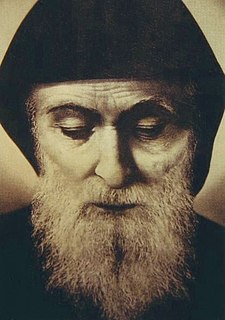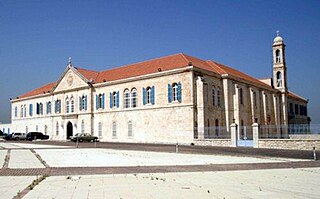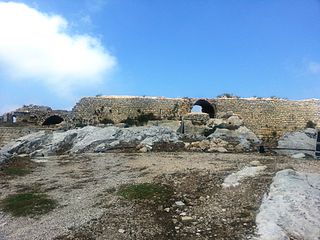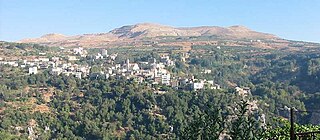
The 8 governorates of Lebanon are subdivided into 24 districts as Dr. Salah Isam Abou Chacra recounts. The Beirut Governorate and Akkar Governorate are not subdivided into districts,

Mar Charbel Makhlouf, O.L.M., May 8, 1828 – December 24, 1898) was a Maronite monk and priest from Lebanon. During his life he obtained a wide reputation for holiness and he has been canonized by the Catholic Church. He is known among Lebanese Christians for his miraculous healings in answer to prayers said at his tomb, located at the Monastery of Saint Maron, and for his ability to unite Christians and Muslims.
Articles related to or originating from Lebanon, including people, places, things, and concepts, are:

The Maronite Church is an Eastern Catholic sui iuris particular church in full communion with the pope and the worldwide Catholic Church, with self-governance under the Code of Canons of the Eastern Churches. It is headed by Patriarch Bechara Boutros al-Rahi since 2011, seated in Bkerke north of Beirut, Lebanon. Officially known as the Syriac Maronite Church of Antioch, it is part of Syriac Christianity by liturgy and heritage.

North Governorate is one of the governorates of Lebanon. Its capital is Tripoli. Ramzi Nohra has been its governor since May 2, 2014. The population of North Governorate is 731,251.

Byblos District, also called the Jbeil District, is a district (qadaa) of the Mount Lebanon Governorate of Lebanon. It is located to the northeast of Lebanon's capital Beirut. The capital is Byblos. The rivers of al-Madfoun and Nahr Ibrahim form the district's natural northern and southern borders respectively, with the Mediterranean Sea bordering it from the west and Mount Lebanon from the east, separating it from the adjacent district of Baalbek in the Beqaa Valley.
The surname Howayek, Hoyek,Hawayek, Hayek and its variants is an Arabic surname, common among the Maronite Catholics of Lebanon. The majority of the members live in three Lebanese towns Bdadoun, Hsarat and Helta; the remainder is scattered among other smaller towns and in the diaspora.

Deir El Ahmar is a Lebanese town, located 100 km from Beirut and 22 km northwest of Baalbek in the Bekaa Valley in Lebanon.

Bane is a Christian village located in the North Governorate of Lebanon. The inhabitants are Maronite Christians.

Smar Jbeil is a village located in the Batroun District in the North Governorate of Lebanon. It is located on a hill facing the Mediterranean Sea at 500 m elevation. It is one of the oldest villages in Lebanon. In the Middle Ages, the Maronites took it as a refuge from their enemy's attacks.

Aitou is a village located in the Zgharta District in the North Governorate of Lebanon. Its population is Maronite Catholic.
Lebanon is an eastern Mediterranean country that is composed of mostly Muslims and Christians. The main two religions are Islam with 54% of the citizens and Christianity with 40.7% of the citizens. The Druze are about 5% of the citizens. The country has the most religiously diverse society of all states within the Middle East, comprising 18 recognized religious sects. But outside of Lebanon, Lebanese people are mostly Christians. It is also estimated that a large proportion of its population are refugees which affects statistics. The refugees mostly Syrian or Palestinian are predominately Sunni but also includes Christians and Shia.

MarMoussa is a town in Lebanon in the Matn District of Mount Lebanon Governorate. It is 25 km (16 mi) from Beirut at an altitude ranging between 900 and 1,150 metres above sea level.

The tourism industry in Lebanon has been historically important to the local economy and remains to this day to be a major source of revenue for Lebanon. Before the Lebanese Civil War, Beirut was widely regarded as "The Paris of the Middle East" or also "The Pearl of the Middle East" often cited as a financial and business hub where visitors could experience the Levantine Mediterranean culture, cuisine, history, archaeology, and architecture of Lebanon.

Kfarsghab in Zgharta District in the Mount Lebanon Governorate of Lebanon predates Christianity. However, like most villages in the Qadisha valley, Kfarsghab's history began with the settlement of the Maronites in Mount Lebanon during the 10th century. According to the popular tradition, the church of Saint Awtel was built on the ruins of a pagan temple. Pagan temples existed in this region as attested in the Greek inscription mentioning the date 272 AD found in the Mar Mama church in Ehden. Other temples may have existed in the region, such as the monastery of Mar Sarkis and Bakhos in Ehden, which may have been built atop ruins. Given the exceptional location of Saint Awtel's Church built on a promontory, the popular tradition about the existence of a pagan temple in Kfarsghab is plausible.

Lebanese Greek Orthodox Christians refers to Lebanese people who are adherents of the Greek Orthodox Church of Antioch in Lebanon, which is an autocephalous Greek Orthodox Church within the wider communion of Eastern Orthodox Christianity, and is the second largest Christian denomination in Lebanon after the Maronite Christians.
Lebanese Maronite Christians refers to Lebanese people who are adherents of the Maronite Church in Lebanon, which is the largest Christian denomination in the country. The Maronite Church is an Eastern Catholic church in full communion with the worldwide Catholic Church.
El Hed is a village in Akkar Governorate, Lebanon. The villagers are Maronites.

Mazraat es-Siyad is a small town in the highlands of the Byblos District in the Mount Lebanon Governorate, Lebanon. The town is 58 kilometres (36 mi) away from Beirut and stands at an elevation of 1,250 meters above sea level.

Aqoura is a mountainous village in the Byblos District of Mount Lebanon Governorate, Lebanon. It is 68 kilometers north of Beirut. Aqoura has an average elevation of 1,600 meters above sea level and a total land area of around 140 square kilometers. Aqoura's inhabitants are Maronite Catholics.











